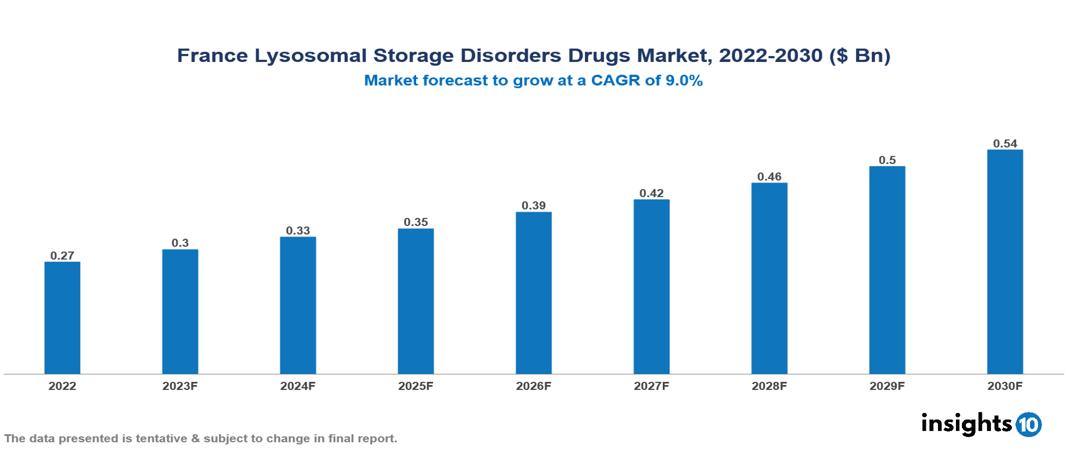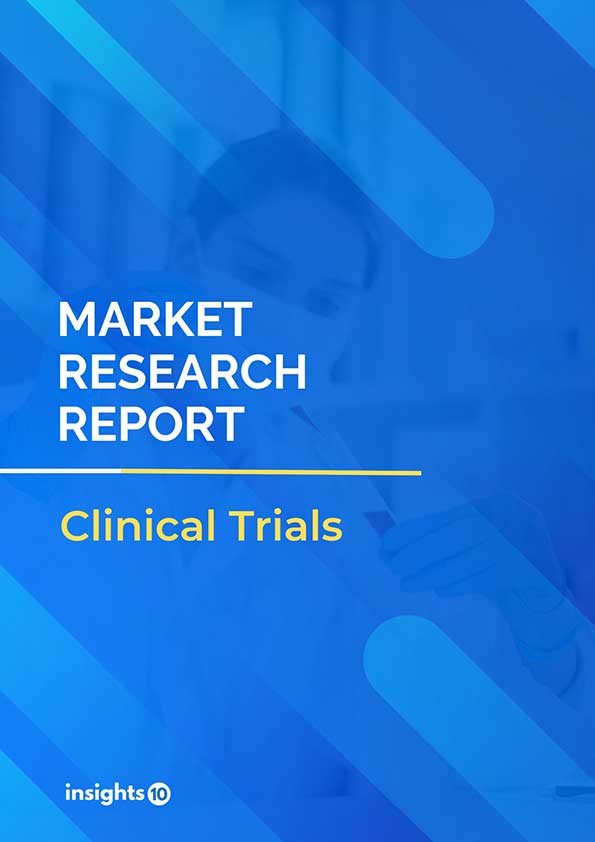France Lysosomal Storage Disorders Drugs Market Analysis
France Lysosomal Storage Disease Drugs Market is projected to grow from $xx Mn in 2023 to $xx Mn by 2030, registering a CAGR of xx% during the forecast period of 2023 ? 2030. The rise in lysosomal diseases, greater public awareness of unusual lysosomal storage disorders, increased research and development for diagnostics, and increased drug development for treating lysosomal diseases are the main drivers impacting the market for lysosomal storage disease treatments. Major global players in Lysosomal Storage Disease Drugs Market are Pfizer Inc, Takeda Pharmaceutical Company Limited (Shire Plc), Sanofi (Genzyme Corporation), BioMarin, Johnson & Johnson (Actelion Pharmaceuticals Ltd), Amicus Drugs, Inc, Alexion Pharmaceuticals, Inc, Sigilon Drugs, Inc, and Orphazyme A/S are some of the companies that participate in this industry.
Buy Now


France Lysosomal Storage Disorders Drugs Market Analysis Summary
France Lysosomal Storage Disorders Drugs Market is valued at around $0.27 Bn in 2022 and is projected to reach $0.54 Bn by 2030, exhibiting a CAGR of 9% during the forecast period 2023-2030.
Lysosomal enzyme shortage or dysfunction results in a set of uncommon inherited metabolic disorders known as lysosomal storage diseases. Fabry disease, Gaucher disease, glycogen storage disease II, Tay-Sachs disease, aspartyl glucosaminuria, Batten disease, cystinosis etc are examples of lysosomal storage diseases. Currently, 11 lysosomal storage diseases can be treated using 23 orphan drugs. There are roughly 50 of these ailments in all, and they can affect the skeleton, brain, skin, heart and central nervous system among other bodily components. Treatments available are enzyme replacement therapy in which missing or deficient enzyme is given to individuals example Imiglucerase (Cerezyme) and velaglucerase alfa (VPRIV): Used for the treatment of Gaucher disease. Agalsidase alfa (Replagal) and agalsidase beta (Fabrazyme): Used for the treatment of Fabry disease. Alglucosidase alfa (Myozyme) and alglucosidase alfa (Lumizyme): Used for the treatment of Pompe disease. Substrate reduction therapy main aim is to reduce the production or accumulation of substrates that cannot be metabolized due to enzyme deficiencies example miglustat (Zavesca), used for the treatment of Gaucher disease. Chaperone Therapy in which the use of small molecules that can stabilize and improve the function of misfolded enzymes is done example Migalastat (Galafold). Major global players in Lysosomal Storage Disease Drugs Market are Pfizer Inc, Takeda Pharmaceutical Company Limited (Shire Plc), Sanofi (Genzyme Corporation), BioMarin, Johnson & Johnson (Actelion Pharmaceuticals Ltd), Amicus Drugs, Inc, Alexion Pharmaceuticals, Inc, Sigilon Drugs, Inc, and Orphazyme A/S are some of the companies that participate in this industry.
Market Dynamics
Market Drivers
It is anticipated that throughout the course of the projection period, the global market for therapies for lysosomal storage diseases will expand due to the significant prevalence of LSDs. Additionally, it is hoped that increased public awareness of uncommon diseases, Orphan Drug Designation and Incentives for research and development will encourage market expansion.
Market Restraints
The high cost associated with the treatment and lack of skilled professionals treating this disease acts as market growth restraint.
Developments of France Lysosomal Storage Disease Drugs Market
In January 2020, Quest Diagnostics bought Blueprint Genetics to increase the range of its product offerings for uncommon and genetic disorders.
Key players
uniQure Orchard Therapeutics AveXis Pfizer Alexion Pharmaceuticals Genzyme Sangamo Therapeutics Magenta Therapeutics Ceregene Ionis Pharmaceuticals1. Executive Summary
1.1 Disease Overview
1.2 Global Scenario
1.3 Country Overview
1.4 Healthcare Scenario in Country
1.5 Patient Journey
1.6 Health Insurance Coverage in Country
1.7 Active Pharmaceutical Ingredient (API)
1.8 Recent Developments in the Country
2. Market Size and Forecasting
2.1 Epidemiology of Disease
2.2 Market Size (With Excel & Methodology)
2.3 Market Segmentation (Check all Segments in Segmentation Section)
3. Market Dynamics
3.1 Market Drivers
3.2 Market Restraints
4. Competitive Landscape
4.1 Major Market Share
4.2 Key Company Profile (Check all Companies in the Summary Section)
4.2.1 Company
4.2.1.1 Overview
4.2.1.2 Product Applications and Services
4.2.1.3 Recent Developments
4.2.1.4 Partnerships Ecosystem
4.2.1.5 Financials (Based on Availability)
5. Reimbursement Scenario
5.1 Reimbursement Regulation
5.2 Reimbursement Process for Diagnosis
5.3 Reimbursement Process for Treatment
6. Methodology and Scope
Market Segmentations For France Lysosomal Storage Disease Drugs Market
By Treatment Therapy
- Enzyme Replacement Therapy
- Velaglucerase Alfa
- Taliglucerase Alfa
- Agalsidase beta
- Laronidase
- Imiglucerase
- Other Enzyme Replacement Therapies
- Substrate Reduction Therapy
- Eliglustat
- Miglustat
- Other Substrate Reduction Therapies
- Stem cell transplantation
By Type
- Gaucher disease
- Cystinosis
- Pompe Disease
- Fabry Disease
- Tay-Sachs disease
By Distribution channel
- Hospital Pharmacies
- Retail Pharmacies
- Online Pharmacies
By Route of Administration
- Oral
- Parenteral
- Others
By End-Users
- Hospitals
- Specialty Clinics
- Homecare
- Others
Methodology for Database Creation
Our database offers a comprehensive list of healthcare centers, meticulously curated to provide detailed information on a wide range of specialties and services. It includes top-tier hospitals, clinics, and diagnostic facilities across 30 countries and 24 specialties, ensuring users can find the healthcare services they need.
Additionally, we provide a comprehensive list of Key Opinion Leaders (KOLs) based on your requirements. Our curated list captures various crucial aspects of the KOLs, offering more than just general information. Whether you're looking to boost brand awareness, drive engagement, or launch a new product, our extensive list of KOLs ensures you have the right experts by your side. Covering 30 countries and 36 specialties, our database guarantees access to the best KOLs in the healthcare industry, supporting strategic decisions and enhancing your initiatives.
How Do We Get It?
Our database is created and maintained through a combination of secondary and primary research methodologies.
1. Secondary Research
With many years of experience in the healthcare field, we have our own rich proprietary data from various past projects. This historical data serves as the foundation for our database. Our continuous process of gathering data involves:
- Analyzing historical proprietary data collected from multiple projects.
- Regularly updating our existing data sets with new findings and trends.
- Ensuring data consistency and accuracy through rigorous validation processes.
With extensive experience in the field, we have developed a proprietary GenAI-based technology that is uniquely tailored to our organization. This advanced technology enables us to scan a wide array of relevant information sources across the internet. Our data-gathering process includes:
- Searching through academic conferences, published research, citations, and social media platforms
- Collecting and compiling diverse data to build a comprehensive and detailed database
- Continuously updating our database with new information to ensure its relevance and accuracy
2. Primary Research
To complement and validate our secondary data, we engage in primary research through local tie-ups and partnerships. This process involves:
- Collaborating with local healthcare providers, hospitals, and clinics to gather real-time data.
- Conducting surveys, interviews, and field studies to collect fresh data directly from the source.
- Continuously refreshing our database to ensure that the information remains current and reliable.
- Validating secondary data through cross-referencing with primary data to ensure accuracy and relevance.
Combining Secondary and Primary Research
By integrating both secondary and primary research methodologies, we ensure that our database is comprehensive, accurate, and up-to-date. The combined process involves:
- Merging historical data from secondary research with real-time data from primary research.
- Conducting thorough data validation and cleansing to remove inconsistencies and errors.
- Organizing data into a structured format that is easily accessible and usable for various applications.
- Continuously monitoring and updating the database to reflect the latest developments and trends in the healthcare field.
Through this meticulous process, we create a final database tailored to each region and domain within the healthcare industry. This approach ensures that our clients receive reliable and relevant data, empowering them to make informed decisions and drive innovation in their respective fields.
To request a free sample copy of this report, please complete the form below.
We value your inquiry and offer free customization with every report to fulfil your exact research needs.









































